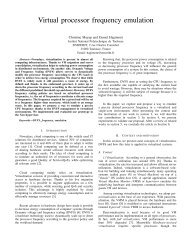SESSION NOVEL ALGORIHMS AND APPLICATIONS + ...
SESSION NOVEL ALGORIHMS AND APPLICATIONS + ...
SESSION NOVEL ALGORIHMS AND APPLICATIONS + ...
You also want an ePaper? Increase the reach of your titles
YUMPU automatically turns print PDFs into web optimized ePapers that Google loves.
30 Int'l Conf. Foundations of Computer Science | FCS'11 |<br />
secret image. Hence we can finger out the secret when<br />
stacking at least 4 shares. For the following algorithm,<br />
let m = n 2 n n<br />
– 2n = ( n − 3)<br />
C1<br />
+ Cn<br />
−1<br />
=<br />
n<br />
n 2<br />
n −5n<br />
+ 6 n<br />
C2 ( n − 2)<br />
Cn<br />
+ C 2 0<br />
+ .<br />
(4, n) scheme algorithm:<br />
Input: A binary secret image S with size w × h and the<br />
value of n.<br />
Output: n shares R1, R2, …, Rn, each with size w × h.<br />
1. Let C0 = [M(n, 2)||(n – 3) × M(n, n)||((n 2 – 5n + 6)<br />
/ 2) × M(n, 0)] and C1 = [(n – 3) × M(n, 1)||M(n,<br />
n – 1)], the size of C0 and C1 are both n × m.<br />
2. for (1 ≤ i ≤ h ; 1 ≤ j ≤ w)<br />
t = random(1..m);<br />
for (1 ≤ k ≤ n)<br />
if (S(i, j) == 0)<br />
Rk(i, j) = C0(k, t);<br />
else<br />
Rk(i, j) = C1(k, t);<br />
Theorem 1. In the proposed scheme, we stack at least<br />
four shares can reveal the secret, and stack one, two or<br />
three shares cannot.<br />
Proof. We use the light transmission rate to prove that<br />
we cannot recognize the secret if we stack less than<br />
four shares, but we can see the image if at least four<br />
shares stack together. We divided into five cases. The<br />
first three cases are to prove that if we stack less than<br />
four shares, the light transmission rate for the white<br />
and black pixel of the stacked image are in the same.<br />
The last two cases prove the light transmission rate<br />
for the white pixel of the stacked image is larger than<br />
the light transmission rate for the black pixel of the<br />
stacked image when at least four shares stack together.<br />
Therefore we can obey the (4, n)-threshold secret<br />
sharing scheme. For A = C0 or C1, consider the<br />
proposed algorithm, the definition of fi(A) and ℑ = 1 −<br />
(b / p), we have ℑ = 1 − (fi(A) / m) = ℑ(A, k). Note<br />
that Lemma 1 will be used in the following proof.<br />
Case 1. For any one share<br />
ℑ(C0, 1)<br />
1 − ,|− ,| ,<br />
<br />
<br />
=1 − , + − , + <br />
,<br />
−<br />
= − + <br />
− ,<br />
ℑ(C1, 1)<br />
= 1 − − ,||, − <br />
<br />
= 1 − − , + , − <br />
−<br />
= − + <br />
− .<br />
So ℑ(C0, 1) = ℑ(C1, 1) when one get one share,<br />
and one cannot see any information.<br />
Case 2. Stack any two shares<br />
ℑ(C0, 2)<br />
= 1 − ,|− ,| ,<br />
<br />
<br />
= 1 − , + − ,+ <br />
,<br />
−<br />
= − + <br />
− ,<br />
ℑ(C1, 2)<br />
= 1 − − ,||, − <br />
<br />
= 1 − − , + ,−<br />
− + −<br />
= − + <br />
− .<br />
So ℑ(C0, 2) = ℑ(C1, 2). That means when<br />
stacking any two shares, we cannot see any<br />
information.<br />
Case 3. Stack any three shares<br />
ℑ(C0, 3)<br />
= 1 − ,||− ,|| ,<br />
<br />
<br />
=1− , + − , + ,<br />
<br />
− <br />
= − + <br />
− ,<br />
ℑ(C1, 3)<br />
= 1 − ,||, <br />
<br />
= 1 − − , + ,−<br />
− <br />
− + <br />
− .<br />
Again, ℑ(C0, 3) = ℑ(C1, 3) when stacking any<br />
three shares, so we cannot see any information.<br />
Case 4. Stack any four shares<br />
ℑ(C0, 4)<br />
= 1 − ,– , ,<br />
<br />
<br />
=1 − , + − , + <br />
<br />
,<br />
− <br />
= − + <br />
− ,<br />
ℑ(C1, 4)









